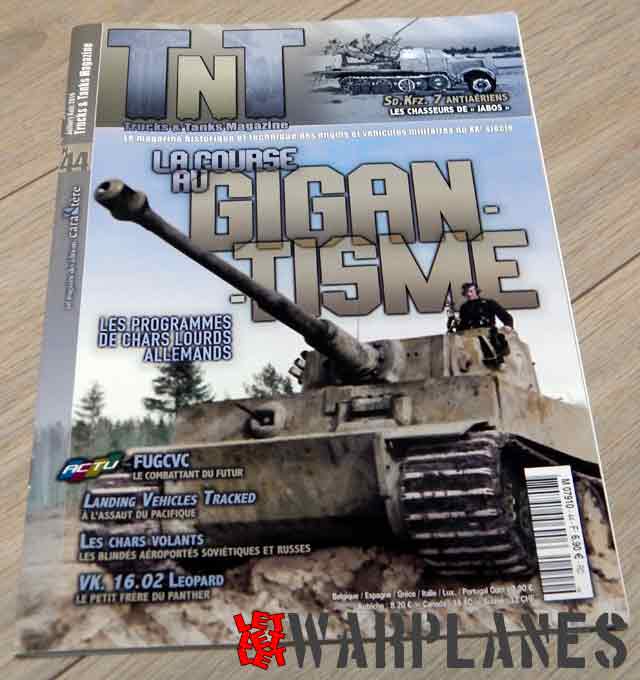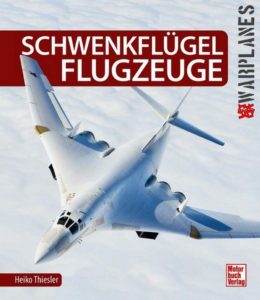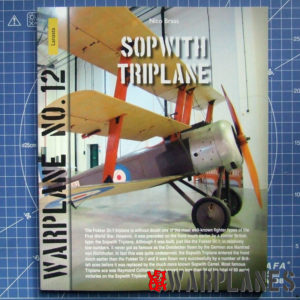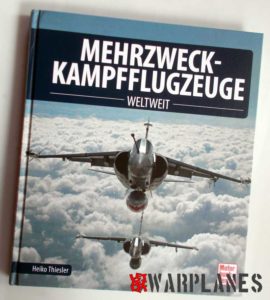TNT 44
No holidays for the team of the French TNT magazine; and it’s great value for the readers!

As always full of interesting and instructive articles, the magazine focuses this time on the race to always bigger tanks made by the German army during WWII. But it’s not the only subject to read, of course:
- FUGCVC (Futuristic Manned Ground Combat Vehicles Crusher): will the robots replace men in conflicts in the future…
That article focuses on the research and development of prototypes of robots that are not similar to a “Terminator” (see the film of James Cameron) but more wheeled vehicles being self driven. Actual researches are for a combat vehicle and a reconnaissance one.
If it is not envisaged further development of those vehicles, they will serve as trial platforms for other concepts.
- The Anglo-saxons tanks bearing German crosses, or the use by Germans of captured tanks
Perheaps not so known: Germans and Allies (especially the Russians) used captured vehicles against their first owners! Germans re-used vehicles captured in all the conquered lands (like Belgium, The Netherlands, France…). The article depicts the anglo-saxon vehicles captured and re-used. In Afrika, but also iN Italy and on the Western front. There were such “German” Mathilda’s, Shermans, M3’s and so on.
- LVT (Landing Vehicles Tracked) in use in the Pacific
Originally developed in 1932 as a civil rescue vehicle for use after Ouragans and other big storms, the LVT rapidly interested the US army. Very useful to transport troops from vessels to the beaches, and to transport support material. The article depicts the different models used in the Pacific.
- Anti-aircrafts Sd.Kfz.7
En of the Thirties, the German army tried to develop anti-aircraft vehicles. But due to the lack of tracked platforms, the idea was made to use semi-tracked vehicles.
Those vehicles will prove to be useful against “Jabos” (Jäger-Bombers) but also against some ground objectives!
- “La course au gigantisme” (The race to bigger tanks): very long and well documented article!!!
If it’s the truth that the production of heavy tanks started as an answer against the Soviet T-34 after the invasion of Russia in 1941, the German industry studied since the mid-thirties numerous projects of heavy tanks. The way to the fabulous Tiger II was often a long one, with many proposals, many technical errors, hard lobbying and fantaisist dreams of some engineers…
- The Soviet “flying tanks”: the airlifted Soviet and Russian tanks
After the end of WWII, the airlifted Soviet forces (VDV) were integrated under the command of the ground forces. The VDV had to have the capacity to be dropped on objectives situated 300km behind the frontline. So there were equipped with material permitting to counter a tank assault. The article depicts the material used by the VDV: ASU-57, ASU-852S25 Sprut-SD…
- Gefechtsaufklärer VK.16.02 Leopard
When preparing their programs for the Panzer V Panther and Panzer VI Ausf. E Tiger, the Germans planned also the development of a “Gefechtsaufklärer” (a “battle observer”. That project would have gived the VK.16.02 Leopard, the “little brother” of the Panther…
History, characteristics and some drawings are presented here.
- FV4201 Mark 5/P Iranian Chieftain versus Iraki T-62 model 1972
As always, the magazine ends with an article depicting two opponents during a war. This time it’s the war between Iran-Iraq.
All the characteristics of both vehicles are presented: protection, mobility, firepower, engines, capacity to go through obstacles…
The conclusion gives a very light advantage to the Chieftain, but T-62 remained a strong adversarie…
Lot of photos; very comprehensive texts (for those of you who can understand French language of course); it’s really a must to read for everyone having interest for AFV’s…
Daniel Clamot








